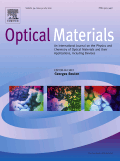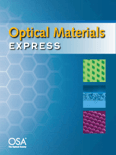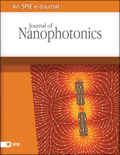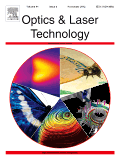
JOURNAL OF OPTOELECTRONICS AND ADVANCED MATERIALS
Scope & Guideline
Driving Excellence in Optoelectronics and Material Science
Introduction
Aims and Scopes
- Optoelectronic Devices and Sensors:
Research related to the design, fabrication, and characterization of optoelectronic devices, including solar cells, LEDs, lasers, and sensors, focusing on enhancing performance and achieving novel functionalities. - Nanostructured and Advanced Materials:
Exploration of nanostructured materials, including their synthesis and application in optoelectronic devices, with an emphasis on materials such as metal oxides, chalcogenides, and hybrid nanocomposites. - Theoretical and Computational Modelling:
Application of theoretical frameworks and computational methods to understand the electronic, optical, and structural properties of materials, aiding in the design of new optoelectronic systems. - Photonics and Optical Engineering:
Investigation into photonic devices and systems, including waveguides, photonic crystals, and metamaterials, focusing on their applications in communication and sensing technologies. - Environmental and Biomedical Applications:
Research on the application of optoelectronic materials and devices in environmental monitoring, medical diagnostics, and biophotonics, highlighting their role in addressing societal challenges.
Trending and Emerging
- Advanced Nanomaterials for Optoelectronics:
There is a notable increase in research focused on advanced nanomaterials, such as quantum dots and 2D materials, which are being explored for their unique optical and electronic properties in optoelectronic applications. - Integration of Machine Learning in Optoelectronics:
Emerging themes include the application of machine learning techniques for optimizing device performance, material discovery, and predictive modeling, showcasing an interdisciplinary approach to traditional optoelectronics. - Flexible and Wearable Optoelectronic Devices:
Research on flexible and wearable devices is on the rise, driven by the demand for lightweight, adaptable technologies in health monitoring, smart textiles, and consumer electronics. - Biophotonics and Environmental Sensing:
There is a growing focus on the application of optoelectronic materials in biophotonics and environmental sensing, highlighting their potential in medical diagnostics and ecological monitoring, which aligns with global sustainability goals. - Terahertz Technology:
Recent publications indicate an increasing interest in terahertz materials and devices, exploring their applications in imaging, sensing, and communication, marking a significant technological frontier in optoelectronics.
Declining or Waning
- Classical Semiconductor Physics:
Research centered around traditional semiconductor physics and device principles appears to have diminished, as newer materials and technologies gain prominence in the field. - Conventional Photovoltaic Technologies:
The focus on conventional silicon-based photovoltaic technologies is decreasing, likely due to the increasing interest in perovskite solar cells and other novel materials that promise better efficiency and versatility. - Basic Optical Characterization Techniques:
Papers solely dedicated to conventional optical characterization methods without novel applications or advancements are becoming less frequent, indicating a shift towards more integrated and application-focused studies. - Static Optical Sensors:
The research on static, non-adaptive optical sensors is waning, as there is a growing trend towards dynamic and responsive sensing systems that incorporate advanced materials and machine learning.
Similar Journals

Materials Letters-X
Pioneering Rapid Discoveries in Material ResearchMaterials Letters-X, published by ELSEVIER, is an esteemed open-access journal dedicated to the rapid communication of research in the fields of Condensed Matter Physics, Materials Science, Mechanical Engineering, and Mechanics of Materials. Launched in 2019, this journal has quickly established itself within the academic community, achieving Q3 quartile rankings in several categories according to the 2023 metrics. The journal's impactful contributions are reflected in its Scopus rankings, notably within Mechanical Engineering (Rank #308) and Mechanics of Materials (Rank #199). The open-access model promotes widespread dissemination and accessibility, ensuring that cutting-edge advancements in material science are readily available to researchers, professionals, and students worldwide. As it continues to grow, Materials Letters-X aims to inspire innovation and collaboration across disciplines, making it a pivotal resource for those engaged in material research and applications.

Advanced Electronic Materials
Connecting Researchers to Transformative Material DiscoveriesAdvanced Electronic Materials is an esteemed journal published by Wiley, dedicated to the forefront of materials science, particularly in the areas of electronic, optical, and magnetic materials. With a commendable impact factor that places it in the Q1 quartile of its category and a Scopus rank of 36 out of 284, the journal is a vital resource for researchers, professionals, and students aiming to contribute to this rapidly evolving field. Launched in 2015 and fully transitioned to Open Access in 2023, the journal promotes widespread dissemination of knowledge, ensuring accessibility to groundbreaking research findings. With its address located in Germany at 111 River St, Hoboken 07030-5774, NJ, it serves a global academic community eager to explore innovative materials technologies that influence diverse applications ranging from consumer electronics to advanced manufacturing. As researchers seek to push the boundaries of what is possible with materials, Advanced Electronic Materials stands as a premier platform for sharing, discovering, and advancing knowledge in this essential domain.

Advanced Photonics Research
Fostering Collaboration, Driving DiscoveryAdvanced Photonics Research is a leading open-access journal published by WILEY, dedicated to advancing the field of photonics through rigorous research and comprehensive reviews. With its ISSN 2699-9293, the journal aims to disseminate innovative findings in areas such as photonic materials, devices, systems, and applications. Since transitioning to an Open Access model in 2020, it has significantly increased accessibility for researchers, professionals, and students alike, promoting wider dissemination and collaboration within the global photonics community. The journal's commitment to high-quality, peer-reviewed content ensures it remains an essential resource for those seeking to stay at the forefront of photonics research. Positioned to influence both academia and industry, Advanced Photonics Research is an invaluable platform for sharing cutting-edge discoveries that drive the future of technology.

OPTICAL MATERIALS
Connecting Science and Engineering through LightOPTICAL MATERIALS is a peer-reviewed journal published by Elsevier, focusing on the intricate field of optical materials within various scientific domains including atomic and molecular physics, electronic engineering, and chemistry. With an impact factor indicative of its relevance, it ranks in the Q2 category across multiple areas such as Electrical and Electronic Engineering, and Inorganic Chemistry, highlighting its critical position in advancing research and innovation. Established in 1992 and continuing its contribution until 2024, this journal serves as a vital resource for researchers and professionals aiming to disseminate significant findings in material sciences, particularly those related to optical properties and applications. While it does not offer open access, the journal remains essential for academia and industry alike, ensuring the continued exchange of valuable knowledge in this rapidly evolving field.

Optical Materials Express
Fostering collaboration in the science of light and materials.Optical Materials Express is a leading open-access journal dedicated to the rapid dissemination of research in the field of optical materials, published by the esteemed Optica Publishing Group. Since its inception in 2012, the journal has played a pivotal role in advancing knowledge and innovation in Electronic, Optical, and Magnetic Materials, currently maintaining a commendable Q2 classification in the 2023 category rankings. With a Scopus rank of 86 out of 284 in its category, the journal proudly boasts a 69th percentile positioning, underscoring its impact and relevance within the scientific community. The journal publishes high-quality, peer-reviewed articles that explore both fundamental and applied aspects of optical materials, making it an essential resource for researchers, professionals, and students alike. Located in Washington, DC, and accessible to a global audience, Optical Materials Express continues to foster collaboration and innovation among scholars in this vibrant field.

Journal of Ovonic Research
Fostering Interdisciplinary Insights in Ovonic Research.Journal of Ovonic Research is a distinguished publication dedicated to advancing the fields of electronic, optical, and magnetic materials. Published by VIRTUAL CO PHYSICS SRL, this journal offers a platform for researchers to share innovative findings and developments that push the boundaries of technology and materials science. With an ISSN of 1842-2403 and an E-ISSN of 1584-9953, it provides an important service to the academic community, particularly within Romania and beyond. Despite its recent inception in 2011, the journal has gained traction in the academic landscape, reflecting a Q4 quartile ranking in crucial categories such as Electronic, Optical and Magnetic Materials, as well as in Physics and Astronomy. The Scopus rankings further underscore its positioning, ranking within the 25th to 37th percentile across various disciplines, making it a valuable resource for professionals and students alike. Although the journal currently operates on a non-open access basis, it remains committed to exploring the latest advancements in materials science, encouraging interdisciplinary collaboration and fostering a deeper understanding of surface, coating, and film technologies. As the field evolves, Journal of Ovonic Research stands as a beacon for scholarly communication, bridging the gap between research and practical application.

eLight
Pioneering Discoveries in the Dynamic World of PhysicseLight is a leading academic journal published by SPRINGER NATURE, dedicated to the dynamic field of Atomic and Molecular Physics, as well as Electronic, Optical, and Magnetic Materials. Launched in 2021, the journal has quickly established itself as a reputable source of cutting-edge research, evidenced by its impressive Q1 quartile rankings in both categories for 2023, alongside remarkable Scopus rankings that place it in the top 2% of its fields. With a commitment to advancing knowledge and fostering innovation, eLight invites contributions from researchers, professionals, and students who are passionate about exploring new frontiers in these critical areas of study. Hitting a critical intersection of physics and materials science, the journal provides an open forum for the dissemination of experimental findings, theoretical studies, and application-based research, ensuring accessibility to vital discoveries that drive progress in technology and academia. Located in Singapore, eLight is poised to make significant contributions to the scientific community until at least 2024, and beyond.

Photonics, an esteemed journal published by MDPI, is a leading platform for researchers in the fields of atomic and molecular physics, optics, and instrumentation. Since its inception in 2014, the journal has fostered open access to cutting-edge research, facilitating knowledge dissemination in these dynamic disciplines. With its Q2 ranking in the 2023 Scopus metrics for various categories, including radiology, nuclear medicine, and imaging, Photonics represents a crucial academic resource for professionals and students seeking to advance their understanding and expertise. Located in Basel, Switzerland, the journal plays a pivotal role in bridging theoretical and practical approaches to photonic technologies. Researchers are encouraged to contribute their findings, thereby enriching the journal’s impact and relevance in the global scientific community through collaboration and innovation.

Journal of Nanophotonics
Advancing Photonics Through Innovative ResearchThe Journal of Nanophotonics, published by SPIE-SOC Photo-Optical Instrumentation Engineers, is an esteemed platform dedicated to advancing the field of nanotechnology through pioneering research in photonics. Since its inception in 2007, this journal has become instrumental in disseminating innovative findings and fostering collaborative discussions, especially in the domains of Condensed Matter Physics, Electronic, Optical and Magnetic Materials, and Nanoscience and Nanotechnology. Currently ranked within the Q3 category across these fields, it serves as a vital resource for academics, industry professionals, and students keen on exploring the multifaceted applications and implications of nanophotonic technologies. With its convergence set to continue until 2024, the journal offers a non-open-access model, ensuring rigorous peer-review standards and high-quality publications that contribute to the global body of knowledge.

OPTICS AND LASER TECHNOLOGY
Connecting Theory and Practice in OpticsOPTICS AND LASER TECHNOLOGY, published by Elsevier Science Ltd, is a premier journal dedicated to advancing knowledge in the fields of optics and laser applications. With its impressive Q1 rankings across three critical categories—Atomic and Molecular Physics, and Optics; Electrical and Electronic Engineering; and Electronic, Optical and Magnetic Materials—the journal stands at the forefront of scientific discourse, boasting a significant impact factor that underscores its relevance. Since its inception in 1970, the journal has consistently provided a platform for the dissemination of cutting-edge research, key innovations, and reviews that influence both academic study and practical applications. Although it currently does not have open access options, its rigorous peer-review process and inclusion in esteemed indexing services make it a valuable resource for researchers, professionals, and students seeking to stay informed about the latest developments in optics and laser technology. The journal’s ongoing commitment to quality research ensures it remains a vital publication for those engaged in this dynamic field, with a converged projection extending through 2025.